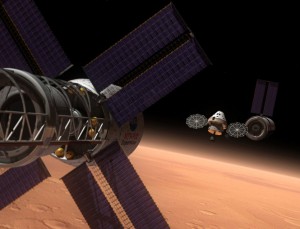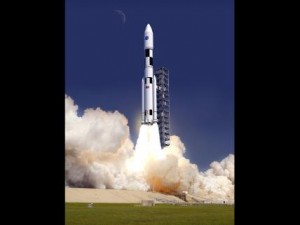A bi-partisan letter from 32 members of the U.S. House urges the White House to structure a “safe, focused and expeditious return of American astronauts to deep space exploration on an American rocket launched from American soil.”
The lawmakers, led by Steven M. Palazzo, chair of the House Science Subcommittee, and Donna F. Edwards, the ranking Democrat on the same panel, hail from 14 states and every region of the U. S. Palazzo, a Republican, comes from Mississippi and Edwards, from Maryland.
The White House laid out a strategy last April, the Asteroid Redirect Mission, which would robotically find, capture and steer a small asteroid into a stable lunar orbit as a destination for U. S. astronauts launched aboard the new NASA Space Launch System heavy lift rocket and the Orion crew capsule. President Obama directed NASA to reach an asteroid with U. S. astronauts by 2025. The directive, issued four years ago, characterized the asteroid visit as a stepping stone to Mars, a destination for the 2030s.
The lawmakers supporting the March 21 letter to the president do not mention ARM or recommend a destination, though they urge Obama to articulate an exploration strategy incorporating the SLS and Orion, which were key features of NASA’s most recent authorization measure, passed and signed by the president in 2010.
Many lawmakers have expressed a preference for the moon as a destination rather than an asteroid. The previous administration’s Constellation program would have established a human lunar base. It was cancelled during the president’s first term because of insufficient funding.
“Since the early 1960s, the U.S. has benefitted greatly from the technological advancements, global space leadership and inspiration that result from NASA’s human spaceflight program,” write the lawmakers. “The achievements in science and technology that we have derived from human space exploration are crucial in advancing our nation’s innovation agenda, and the discoveries yet to be made inspire our future scientists and explorers to pursue studies in Science, Technology, Engineering, and Math (STEM) education.”
The letter: http://palazzo.house.gov/news/documentsingle.aspx?DocumentID=373841
NASA’s half dozen Apollo moon landings concluded in 1972. NASA’s three decade space shuttle program was retired in mid-2011. Without a ready shuttle replacement, the U. S. has turned to Russia to transport astronauts to and from the International Space Station. President Obama has called for a 2020 to 2024 extension of activities aboard the space station in part to establish a business case for NASA’s Commercial Crew Program, an initiative to replace dependence on Russia’s Soyuz with competing U. S. crew space transportation services.
“We must prioritize U.S. leadership in space exploration, especially in light of the expansion of human spaceflight programs in countries such as China and Russia over the past decade,” according to the Congressional letter.
China has a human tended space station in orbit, with plans for a permanently occupied replacement. In December, China’s Chang’e-3 lander reached the lunar surface with a small rover. Though still in communication, the Yutu rover has experienced major technical difficulties.
A U. S. push into deep space will bring benefits to the nation’s economy as well as its national security, according to the lawmakers. The letter makes no mention of recent U. S. and Russian tensions over the Ukraine, which has prompted the two countries to issue a series of competing sanctions affecting economic and international relations.
So far, U. S. and Russian space ties have not been affected.
“It has been often stated that NASA’s funding is an investment, not an expenditure,” according to the letter. “As you are aware, total investment in the agency is less than one half of one percent of the overall federal budget, and less than half of the agency’s budget goes toward human spaceflight. Therefore, less than one-fourth of one penny of each taxpayer dollar is invested in human spaceflight but the rewards are substantial”
The president requested $17.5 billion for NASA in fiscal year 2015, a $190 million decline over the current budget. However, annual out year spending is expected to rise to $18.16 billion in 2019.
In an accompanying statement released March 24, Palazzo added:
“I have always believed that maintaining American leadership in space is a matter of national pride as well as a matter of national security. In these times of international uncertainty, it has never been more evident that NASA must once again commit its focus to the mission of human space exploration. The next few years provide a crucial window in which we must redouble our efforts to once more launch American astronauts on American rockets from American soil. I will continue doing everything in my power to restore that focus to NASA’s budgets as we revisit these matters in the NASA Authorization Act later this year.”
Edwards released a March 24 statement of elaboration as well.
“Human space exploration is a catalyst for American innovation and economic growth. Since President Kennedy issued his challenge, our nation has lead the way in pushing the envelope for human space exploration, inspiring generations of young Americans to pursue careers in the sciences. We must once again put forth a compelling vision for American exploration, a vision that will inspire our engineers, scientists, researchers, and students today – for generations to come. Funding for NASA’s exploration programs is an investment, not an expenditure, and history has proven that the economic returns from these investments are significant.”
In 1962, JFK challenged the nation to reach the moon with human explorers ahead of the former Soviet Union.


